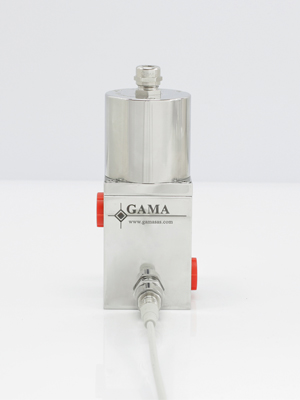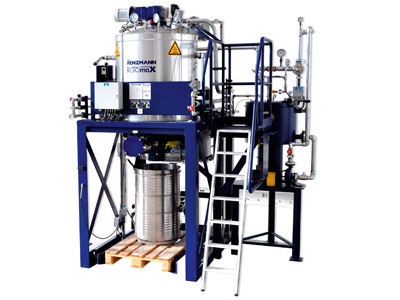The ROTOmaX-e 20 for sustainable solvent recovery from D.W. Renzmann
There are many cogs in the wheel which turns at a flexographic printing facility. In this feature, Neel Madsen looks at a handful of ancillary processes that can improve efficiency and increase sustainability.
Finding the right cleaning products for your consumables, keeping the web clean of contaminants, regulating the viscosity of the ink or recycling your waste products, there are a host of products on the market to cover all aspects of the print and surrounding processes, all aimed at increasing productivity and reducing waste.
Cleaning the Smart way
The Smart range of cleaning products from Print-Tech Solutions has been researched and developed over the last 13 years to provide a safe and effective method of cleaning for print companies. Specifically formulated for the print industry, all products in the product range are non-caustic, non-corrosive and REACH compliant.
Managing director Steve Turner commented, ‘Many companies are still unwittingly using unsuitable, non-specific or harmful cleaning substances without realising the disastrous effects they can have on print. During our site visits, we often find customers using generic cleaning chemicals to remove inks, which can cause immediate or long term damage to sensitive and costly parts of the printing process. A lot of this damage and expense can be prevented by using cleaning products that are specifically formulated for the print industry.’
He went on to explain the advantage of the Smart products for cleaning anilox rollers and printing plates. Even the smallest amount of contamination within the anilox cells can have a serious detrimental effect on ink laydown and subsequent print quality. As a knock on effect of this, printers are having to spend considerable time and money reformulating ink strengths to achieve target ink densities.
Photopolymer plates have also evolved significantly, with the surface finish playing a key role in the way ink is laid down onto the substrate. The need to clean large numbers of plates quickly often leads to the use of aggressive chemicals, which can adversely affect the surface properties of the printing plates even after one use.
Mr Turner said, ‘The key to effective management of anilox and plate cleaning is correct product application – we work closely with customers to provide ongoing support and tailored training, ensuring that print operatives are using our cleaning products in the most cost effective way. To help customers correctly manage their use of cleaning solutions and its impact on the environment, we can also offer various dilution and dosage options.’
Print-Tech Solutions also provides a bespoke service of product development in response to specific customer requirements. Whilst the main Smart product range is limited to 10 cleaning products that cover most applications, there have been over 150 formulations of development products during the past 13 years, which have been formulated to solve particular cleaning needs.
Handling air
Meech International is celebrating the worldwide sale of over 200 AHUv3’s, the company’s first in-house manufactured air handling unit and an integral component to three of its web cleaning technologies, the CyClean, VacClean and ShearClean. The AHUv3 provides the required airflows for the web cleaners, as well as housing the system filters.
‘We decided it was time to focus not just on the technology of the cleaning heads of our systems, but also the technology behind them,’ explained sales director Adam Battrick. ‘As with many of our innovations, this was a customer driven initiative. Feedback indicated there was demand for a solution that guaranteed excellent filtration while also reducing the need for monitoring and operator intervention.’
There are three models of the AHUv3 available: a two-pump compact unit, a three-pump unit and a six-pump unit. The two-pump model’s compact design allows for easier integration in production environments where spacing is an issue, which is quite common in the narrow web industry. The three- and six-pump models are typically used for applications with web widths above 600 mm.
While the AHUv3 shares similarities with previous air handling systems, Meech has now replaced the analogue features of the v1 and v2 units with a graphic display and digital touchscreen that allow remote activation, improved monitoring and personalised settings.
‘If you are running with the CyClean system, the AHUv3 monitors and controls the vacuum and positive pressure,’ explained Mr Battrick. ‘The set target pressure value that appears on the screen will alter as the buttons are pressed, and the unit will self-adjust to meet this requirement.’
The air handling unit has been designed to reduce operator maintenance and intervention. When the filters start to fill with contamination over an extended period of time, the system’s fans will automatically speed up to maintain the operator set performance level of the cleaning system. A signal alarm will alert when the filters need to be cleaned or changed.
Keep the ink flowing
Gama has recently launched two new viscometers, the G33 and G34, for viscosity control of EB inks in flexible packaging. Sales and marketing director Sante Conselvan said, ‘The advantages of products like G33 and G34 lie in the lower environmental impact and in the colour stability, widened by the ink control and correction. Here the Gama solutions come into play and the viscometer becomes an essential accessory to increase the quality and reduce the costs: goals which emerging markets like Middle East and Asia are also working towards.’

The new G34 ink viscometer from Gama was launched at drupa
Meanwhile for temperature control, the company’s new G91 system can be used as standalone to control and correct the ink and adhesive temperature on flexo and gravure presses, with or without a viscosity system.
Gama is also launching new products for the internal logistics of the GI automatic sleeve storage system series. These systems solve the problem of sleeve storage, that require optimal conditions to avoid deformations and consequent impossibility of further use, but also solutions to move and store materials such as rotogravure cylinders, film and paper reels. The automatic and user-adjustable storage systems allow archiving on several levels and has a compact design.
‘Our commitment is to find the most suitable solution for the production needs of the client,’ commented Sergio Puoti, sales manager of the company’s logistics division. ‘We are able to create a storage space of 50 square metres of 5 metres in height which can hold 1000 sleeves.’
The company has also developed new software for viscometers VIS G26 and G29. SOFT-MON-016 features a graphic interface that gives the operator all the information related to viscosity, temperature and pH of the ink. It also measures the amount of solvent or ammonia consumed. The new software offers a more memory and can archive up to 5000 jobs. It communicates with the client’s MIS sending information on the printing process, and with inline spectrophotometres to automatically modify the viscosity value.
Finally, the new G20 system allows the control of the viscosity of solvent-based inks and, if necessary, automatically makes corrections by adding solvent for accurate print quality and to obtain the maximum performance of the press.
Solvent recovery
D.W. Renzmann GmbH develops and manufactures industrial washing machines and solvent distillation units. With more than 40 years of experience in the business, the ATEX-certified manufacturerhas introduced the ROTOmaX-e 20 for sustainable solvent recovery. The distillation unit minimises disposable waste, thereby contributing to active environmental protection.
Climate and imission protection regulations make specific demands on cleaning processes, such as the restrictive use of solvents. The new ROTOmaX-e vaporises and condenses used solvent in a sustainable process, minimizing the quantity of highly viscous waste. Once the solvent in the distillation vessel reaches a predefined level, distillation starts automatically. The solvent is heated via an insulated, level heating floor until it boils and vaporizes. At a distillation rate of 60-120 l/h, the ROTOmaX-e needs only a little over two hours to distill 250 litres of used solvent. At the end of the distillation process, approximately 94% of the high-quality solvent can be reused in various areas.
Once the solvent in the boiler reaches a predefined level, filling stops automatically and distillation begins. An agitator with scrapers (rotor) keeps the heating surfaces free of residues and ensures an optimum heat transfer at all times. After condensation, the rotor automatically transports the reduced residue into a disposal container – manual intervention or cleaning is not required.
The distillation unit comes in two additional sizes: the ROTOmaX-e 15 has a filling capacity of 200 litres and a distillation rate of 45-90 l/h, while the ROTOmaX-e 30 can distil up to 400 litres at a rate of 90-180 l/h.
In the loop
Eurograv has been appointed the sole UK and Ireland sales partner for the complete product portfolio manufactured by PureLoop GmbH, which is part of the Erema Group.
PureLoop manufactures integrated shredder extruder combination (ISEC), turning production waste into high grade plastic pellets, processing both heavy, free flowing as well as light weight and large volume materials.
Based in Ansfelden, in Austria, the company is part of the largest producers of recycling systems in the world, with its parent company employing 480 people worldwide. The family-owned company manufactures virtually all its own equipment in house and can boast one the largest R&D and demonstration centres in the industry.
The shredder extruder combination offers minimal change in MFI and colour variations, the largest possible amount of recycled pellets returned to the production process, up to about 20 % lower operational costs compared to other shredder extruder systems and up to 15% more energy efficient compared to comparable systems.
The company offers a range of feeding systems to suit individual requirements including custom built devices. These have dust free operation for a clean working environment and are safe to use with low noise level designed for the manufacturing environment. The output ranges from 160 kg/hr up to 650 kg/hr depending on the model.






